

EatPES - Home of the Twisted Films of PES. Fiona Hall - Shot Through, Roslyn Oxley9 Gallery, Sydney, 2011. Fiona Hall Artist profile. Sculpture. Language sculpture installation works “CHINA FREAK” from shanghai-based installation artist CHEN XI “HORSES” – graceful sculptures from beijing-based CAO YUN a piece of installation work from shanghai-based installation artist CHEN XI some new installation works from shanghai-based installation artist CHEN XI “IDENTITY” from beijing-based sculptor DING HAO sculpture work from beijing-based sculptor ZHENG XIAOHUI “EIGHTEEN LEVELS OF HELL” from shanghai-based installation artist CHEN XI “SHAN HAI JING” from beijing-based sculptor DING HAO “TOUCH” installation works from guangzhou-based artist BUBU.

Kim Yong Soo. I was delighted to stumble onto the work of Korean artist Kim Yong Soo whose artwork, at first glance, takes on the somewhat familiar appearance of traditional Japanese paintings of cherry tree bossoms. Joseph Cornell Interactive. Joseph Cornell: Navigating The Imagination Launch Page. American artist Joseph Cornell (1903–1972) has been celebrated internationally for his boxes, collages, and films since the 1930s.
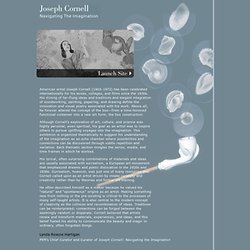
His mining of far-flung ideas and traditions and elegant integration of woodworking, painting, papering, and drawing define the innovation and visual poetry associated with his work. Above all, he forever altered the concept of the box—from a time-honored functional container into a new art form, the box construction. Assemblage (art) Robert Rauschenberg, Canyon, 1959, Assemblage: oil, housepaint, pencil, paper, fabric, metal, buttons, nails, cardboard, printed paper, photographs, wood, paint tubes, mirror string, pillow & bald eagle on canvas, National Gallery of Art, Washington, DC.
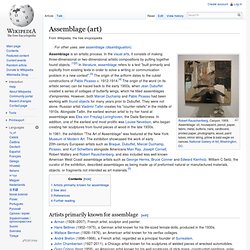
In 1961, the exhibition "The Art of Assemblage" was featured at the New York Museum of Modern Art. The exhibition showcased the work of early 20th-century European artists such as Braque, Dubuffet, Marcel Duchamp, Picasso, and Kurt Schwitters alongside Americans Man Ray, Joseph Cornell, Robert Mallary and Robert Rauschenberg, and also included less well known American West Coast assemblage artists such as George Herms, Bruce Conner and Edward Kienholz.
William C Seitz, the curator of the exhibition, described assemblages as being made up of preformed natural or manufactured materials, objects, or fragments not intended as art materials.[5] Jump up ^ Walker, John. (1992) "Assemblage Art". William C. Found object. Found objects derive their identity as art from the designation placed upon them by the artist and from the social history that comes with the object.

This may be indicated by either its anonymous wear and tear (as in collages of Kurt Schwitters) or by its recognizability as a consumer icon (as in the sculptures of Haim Steinbach). The context into which it is placed (e.g. a gallery or museum) is also a highly relevant factor. The idea of dignifying commonplace objects in this way was originally a shocking challenge to the accepted distinction between what was considered art as opposed to not art. Although it may now be accepted in the art world as a viable practice, it continues to arouse questioning, as with the Tate Gallery's Turner Prize exhibition of Tracey Emin's My Bed, which consisted literally of her unmade and disheveled bed.
In this sense the artist gives the audience time and a stage to contemplate an object. Origin: Duchamp[edit] Development[edit] Commodity sculpture[edit] Kids' APT7- Queensland Art Gallery. Art collection. The Andy Warhol Museum, Installation, Skulls, ©AWF, photo by Paul Rocheleau Over the course of his career, Andy Warhol transformed contemporary art.
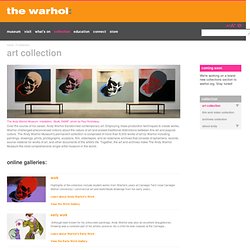
Employing mass-production techniques to create works, Warhol challenged preconceived notions about the nature of art and erased traditional distinctions between fine art and popular culture. Man Ray (American, 1890–1976) American photographer and painter.
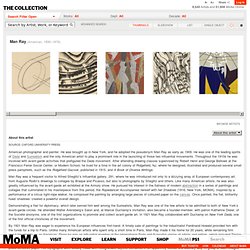
He was brought up in New York, and he adopted the pseudonym Man Ray as early as 1909. He was one of the leading spirits of Dada and Surrealism and the only American artist to play a prominent role in the launching of those two influential movements. Throughout the 1910s he was involved with avant-garde activities that prefigured the Dada movement.
Marcel Duchamp. Marcel Duchamp (French: [maʁsɛl dyʃɑ̃]; 28 July 1887 – 2 October 1968) was a French-American painter, sculptor, chess player, and writer whose work is associated with Dadaism[1][2] and conceptual art,[3] although not directly associated with Dada groups.
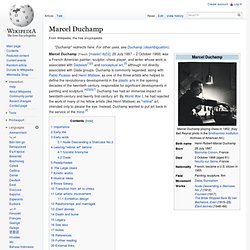
Duchamp is commonly regarded, along with Pablo Picasso and Henri Matisse, as one of the three artists who helped to define the revolutionary developments in the plastic arts in the opening decades of the twentieth century, responsible for significant developments in painting and sculpture.[4][5][6][7] Duchamp has had an immense impact on twentieth-century and twenty first-century art. By World War I, he had rejected the work of many of his fellow artists (like Henri Matisse) as "retinal" art, intended only to please the eye. Instead, Duchamp wanted to put art back in the service of the mind.[8] Importance[edit] Early life[edit]
Circuit Board Fossils, Paintings and Other Found Object Sculptures by Peter McFarlane. Mixed media and installation artist Peter McFarlane has spent his life turning found objects, computer waste and other discarded materials into sculptures, installations, and even the backdrops of paintings.
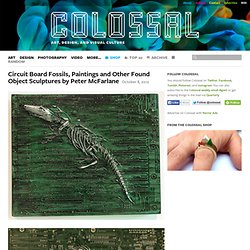
Of his work McFarlane says: To me, waste is just lack of imagination. This belief carries beyond the boundaries of my art production and permeates most aspects of my life. Michelle Stitzlein. Sculptures — Gabrieldishaw.com. Intricate Animal Sculptures Made from Reclaimed CDs. The characteristic reflectivity and round shape of CDs make them stand out like sore thumbs in most sustainable art pieces, leading to a result that can be a bit amateurish.

But some artists have managed to elevate this waste material to a true art medium, creating sculptures that transcend their mundane beginnings. These recycled CD sculptures by Sean Avery are a beautiful example, so artfully formed that you can barely even tell what they’re made of. The Australian artist cuts the CDs into tiny shards and blends them with other materials to create his animal sculptures. Using the translucent blue-green color of the CDs to its full advantage, the sculptures look, at times, as if they’re made of sea glass. Cut and crafted into the feathers of a bird or tufts of fur on a bear, the CD shards make each sculpture look even more multi-dimensional as they glitter in the sun. Junk Sculptures by Dario Tironi. Beauty is in the eye of the beholder, and the work of Italian artist Dario Tironi is evident proof.

While most people look at discarded objects and see only trash, he sees precious materials for his beautiful sculptures. Old toys, discarded computer components, broken calculators, even plastic bottles, they’re all part of Tironi’s recycled universe. Similar to Robert Bradford, who uses old toys for his sculptures, and Leo Sewell, the young Italian artist manages to glue together various junk items and create detailed sculptures of people and animals, and gives everyone who sees his art a whole new perspective on the concept of recycling. Reddit Stumble. Marcel Duchamp (American, born France. 1887–1968) Home. Paramodel. Paramodel, est. 2001, Japan | Yasu hiko Hayashi b.1971 | Yusuke Nakano b.1976 | How to make a paramodel 2012 | PVC pipe, plywood, toys, inkjet prints on canvas, macaroni, ‘Water Works’ card game | Site-specific work for APT7 | Courtesy and ©: The artists.
Found Object Art: 13 Sculptures Made of Reclaimed Items. The term ‘recycled art’ is fairly new, but found object art has been around at least since Marcel Duchamp’s 1917 work ‘Fountain‘, which consisted simply of a used urinal. Artists have been salvaging materials from car parts to kitchen utensils for decades, for inclusion in sculptures, paintings, drawing, collages and other examples of ‘found art’. These 13 works of art incorporate reclaimed objects into everything from small sculptures to large-scale installations. Zac Freeman’s Amazing Found Object Portraits (images via: zac freeman art) Buttons, jar lids, Legos and every kind of small doo-hickey imaginable find their way into the portraits of Zac Freeman, who manages to coax strikingly realistic images out of all this junk.
“I glue the bits of junk to a wooden substrate to form an image, usually faces, which only can be seen at a distance. Drawings on Reclaimed Envelopes by Mark Powell (images via: inhabitat) Eagle Made of Kitchen Utensils (images via: saya kaganz) Darth Vader Goes Green.